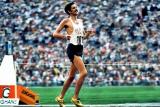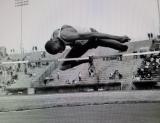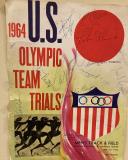Folders |
50th Anniversary: The Case For Frank Shorter As The Greatest Marathoner EverPublished by
The Greatest Marathoner Ever: A Contrary View By Marc Bloom for DyeStat (Note: Originally posted in August of 2021) With the 49th anniversary of Frank Shorter’s historic 1972 Olympic marathon victory at Munich coming up on Sept. 10 — and hopefully a grand commemoration of the 50th next year — I would like to offer a brief on Shorter being the greatest marathoner of all time. What about the invincible Kenyan Eliud Kipchoge? Let’s look at the facts, and try and compare the two eras of Shorter and Kipchoge, almost a half-century apart, to arrive at some logical conclusions. It is easy, and may I say convenient, to feel at the moment that no marathoner could even compare to Kipchoge: he’s right up front in our collective consciousness with one surpassing performance after another, the latest of course, his Olympic gold medal run in sweltering Sapporo. In the same vein, it’s easy to forget the bygone era of Shorter: how primitive it was with no IAAF World Championships, no World Marathon Majors, no pacesetters, few big-city marathons, no Nike, no way to earn a living from running in those amateur days — not yet anyway. And how about those early ‘70s vintage running shoes! Slapped together, about as high-tech as Ted Corbitt’s old Hush Puppies. It’s never easy to compare eras in any sport. Babe Ruth or Joe DiMaggio or Willie Mays? Elgin Baylor or Michael Jordan? Jesse Owens or Usain Bolt? More than a few cold ones have been downed on such arguments. But like Kevin Kline said as a presidential double in the charming 1993 film “Dave,” when trying to balance the federal budget without cutting allocations for children’s shelters, "let’s give it a try and see what we come up with." Olympic Marathons: It is common knowledge that the 1976 “winner” in Montreal, Waldemar Cierpinski (also the 1980 “winner” in Moscow), was souped up by the notorious, criminal East German drug machine of the period. He was subsequently discredited in all quarters of the sport. Prior to 1976, Cierpinski had run only two marathons, both in Czechoslovakia, notching a third in 2:20:29 and a seventh in 2:17:31. A number of reports out of Germany in the 1990s detailed East German use of banned substances totaling hundreds (if not thousands) of athletes in various sports. Among the names cited was Cierpinski. Shorter, who placed second, in effect became the champion; and with his Munich victory four years before, Shorter, like Kipchoge (who won in Rio in 2016), had two consecutive Olympic marathon titles to his credit. (The fourth man across the line in Montreal, Don Kardong, moved up to the bronze medal position, while the new runner-up was Karel Lismont of Belgium, also the runner-up to Shorter in ‘72.) Those of us covering the major events of the time, like the IAAF 1985 World Cup in Canberra, Australia, witnessed the drug-boosted domination of the East German women — as well as their obvious male characteristics — despite GDR officials’ attempts at Cold War sequestering when the athletes were not on the track. In Canberra, East German women won every single running event from the 100 meters through the 3,000 meters plus both hurdles events and both relays — topped by the still-standing 47.60 “world record” 400 of Marita Koch (also named in the German expose). There can be no equivocating on what the East Germans wrought. Let’s stop the common reference to Shorter as a gold and silver medalist with an asterisk next to the silver. Nothing about this is debatable. Shorter: two golds. Kipchoge: two golds. In this category it’s a tie. Olympic Marathon Victory Margins: Kipchoge won Tokyo by 80 seconds and Rio by 70 seconds. Domination to be sure. Total: 2 minutes 30 seconds. Shorter won Munich by a modern day victory margin record of 2 minutes 12 seconds (close to a half-mile!). At Montreal he was 27 seconds ahead of Lismont. Total: 2 minutes 39 seconds. Kipchoge vs. Shorter: Close enough to be a tie. Olympic Competition: In 1972, Shorter’s defeated rivals included runner-up Lismont, the 1971 European champion; bronze medalist Mamo Walde of Ethiopia, the 1968 Olympic champion; Shorter’s strong American compatriot Kenny Moore, fourth; Kenji Kimihara of Japan, the 1968 Olympic silver medalist, fifth; Ron Hill of Great Britain, the 1970 Boston Marathon champion who broke the Boston course record by over 3 minutes, sixth; and Derek Clayton, the world record holder (2:08:34 in 1969) who placed 13th. It bears repeating: Shorter defeated the greatest Olympic field assembled to date by over two minutes. In 1976, in addition to Lismont again, and Kardong, Shorter defeated Lasse Viren of Finland, the 5,000 and 10,000 gold medalist for a second straight Olympics (he would have his own doubters regarding performance aids); Jerome Drayton, three-time winner of the Fukuoka Marathon (the de facto world championship), where in 1975 he ran a Canadian record 2:10:09 that stood for 43 years, sixth; Leonid Moiseyev of the Soviet Union, who would be the Fukuoka runner-up the next year and the world’s top-ranked marathoner by Track & Field News the year after that, seventh. (Bill Rodgers, on his way to a collection of four Boston and four New York titles, was injured at Montreal and placed 40th.) In 2016 at Rio, Kipchoge, running 2:08:44, left some heady competition far back. Runner-up Feyisa Lilesa of Ethiopia, 70 seconds behind, had been fourth in the 2010 Rotterdam Marathon in 2:05:23, second at Chicago 2012 in 2:04:52 and bronze medalist in the 2013 World Championships at Daegu, South Korea. The Rio bronze medalist, American Galen Rupp, 11 seconds behind Lilesa, had been the 2012 Olympic silver medalist in the 10,000 at London. Fourth-place Ghirmay Ghebreslassie of Eritrea, about a minute behind Rupp, was the 2015 world marathon champion at Beijing at age 19, and fourth at London in 2016 in a 2:07:46 PR a few months before Rio. Over two minutes out of the medals was the defending Olympic champion, Stephen Kiprotich of Uganda, who was also the 2013 World Champion at Moscow. At Tokyo — or, rather Sapporo — Kipchoge’s main opposition turned out to be Abdi Nageeye, a native Somalian representing the Netherlands, who’d run 2:07:09 at the 2020 Valencia Marathon in Spain — and wound up 15th! — and Nageeye’s training partner, Bashir Abdi, also a Somalian native, and now representing Belgium. In his last two marathons before the Olympics, Abdi took second at Tokyo in 2:04:49 and fifth at Chicago in 2:06:14. In Sapporo, the two men were second and third finishing almost as one. A stride behind the working-together would-be medalists, in fourth, was Lawrence Cherono of Kenya, no less a winner, in 2019, at both Chicago (2:05:45) and Boston (2:07:57) and, most recently before the Games, runner-up at Valencia in 2:03:04. Putting it all together, I’d have to call this one too a toss-up. Both Kipchoge and Shorter defeated every great runner of the day who took the line with room to spare — twice. Obviously, Kipchoge’s opposition had a deeper resume of fast times, owing to the advent of the World Marathon Majors (started in 2006) held on the fastest possible courses with the best conditions and the entourage of pacesetters (more about this to follow), which bears no resemblance to what Shorter et al. dealt with a half-century ago. Non-Olympic Marathon Titles: In Shorter’s day, as stated, Japan’s Fukuoka Marathon in December was considered the World Championship, and just about all the best runners turned out for it annually. Shorter won it four years in a row — in 1971, ’72, ’73 and ’74. His times were 2:12:51, 2:10:30 (his PR and an American record), 2:11:45 and 2:11:32. Shorter won decisively and faced all the Olympic-level greats of the period. He battled winds from many directions as the city faced the sea on three sides. Shorter’s other marathon victories during this Fukuoka span included the 1971 Pan American Games title in Cali, Colombia, in the searing August heat. This was Shorter’s international marathon debut, and his indoctrination included a mid-race bout of turista, forcing a pit-stop at 14 miles, and then a catch-up to take the win. With Shorter’s Fukuoka victories and the two Olympic marathons, he was the top marathoner in the world for six years in a row, from 1971 through 1976, a mighty rein that was unprecedented to that time, and equaled in later years only by Kipchoge himself. Kipchoge has been the world best since 2014 (except for No. 2 in ‘19) when he captured the first of eight straight Marathon Majors, at Chicago. From 2015 through 2019, he added three victories at Berlin and four straight at London. He’s defeated a cavalcade of rocket-fast challengers including the magnificent Ethiopian Kenenisa Bekele no fewer than four times in the marathon. Kipchoge has 10 sub-2:05 times to his credit, led by his 2:01:39 world record at Berlin in 2018. (And of course there’s the much ballyhooed sub-2:00 — the made-for-Hollywood 1:59:40 in Vienna in 2019 — as much a Nike marketing stunt as anything, and a brilliant one at that.) How do Shorter’s four Fukuoka’s compare with Kipchoge’s eight Marathon Majors? (Let’s put aside the times for a moment.) This might seem like an easy call for the Kenyan. Not so fast. Shorter had no big-money world circuit. He was lucky to get expenses. No handcrafted courses. No pacesetters. The marathoners then, compared to now, were like sprinters without starting blocks or 10k guys on a cinder track. They communicated with rotary phones (or maybe yelling out the window). Some addresses had no zip codes yet. The marathon then was college basketball before March Madness, pro football before the Super Bowl. (Ironically it was Shorter more than almost anyone whose behind-the-scenes legwork led to professional running in the 1980s and the riches to be earned by today’s stars.) Still, from the ’71 Pan Ams through Fukuoka ’74 (two and a half years), Shorter won eight marathons including his first Olympics. Kipchoge’s collection of eight cannot be denied, but the “business model” of faster-and-yet faster courses, pace cars, a phalanx of pacesetters and drink retrievers, and all the money and bonuses, I think undercuts the historical grandeur of the marathon and takes just a little something away from the athletes’ accomplishments. Marathons have, in the recent decades, gotten “easier” for the elite. Fast times are a dime a dozen. Great marathon competitors are not. So I’m calling this one a tie as well. Marathon Times: Picking up from the previous category, the super shoes (I won’t debate whether they are “fair” or not) are said to provide a benefit of two or three minutes for a top marathoner. Let’s term it as five seconds per mile, a bit over 2 minutes for the distance. Flat, perfectly “manicured,” ideal-for-fast-times courses that cater to the elite (and their sponsors) account for about another five seconds per mile, compared with those having hills or other “natural” challenges (while not scientific, a reasonable guestimate). Today’s main advantage, drafting off pacesetters, the pace car, etc., is worth I believe about 10 seconds per mile. That totals 20 seconds per mile benefit for Kipchoge et al. If you don’t think drafting is paramount, take a step back and consider the professional peloton in cycling, where an event like the Tour de France is based entirely on subordinates breaking the wind for “G.C. contenders” (the overall three-week race heads of state) and individual stage sprint specialists. In running, it’s not much different, once you bathe the stars in a 360-degree covenant of pacers. Don’t even break stride for a drink; your buddies have you covered. Consider another recent event typical of today’s running landscape that drew an array of notable marathoners seeking fast times and a nice payday: the aforementioned Valencia, run on the pancake flat grounds of Spain’s southeast coast with cooling breezes and low humidity last December. The 17th-place man ran 2:07:26. The win went in 2:03:00 with three more 2:03s and seven more sub-2:06s — all East Africans. (The top four women broke 2:20 with four more under 2:21.) I noted a top men’s finisher at random — 11th-place Oqbe Kibrom of Eritrea — to compare his Valencia performance with an effort in conditions not made-to-order. At Valencia, Kibrom ran 2:05:37. At Sapporo, in the Olympics, he placed 35th in 2:16:57. There’s no one definitive drafting study (maybe such a thing is impossible with all the variables); but what I’ve read and observed leads me to the conclusion that the swaddled superstar in the comfort of protectors on all sides as well as the pace car just ahead results in a bounty of 10 seconds per mile as stated above, roughly a 4-minute advantage. Thus, my total of 20 seconds per mile from the super shoes, super courses and super pacing all together produces about an 8-minute benefit, which makes a lot of sense, at least to me. Shorter’s 2:10, 2:11 and 2:12 times, in today’s “dollars,” are worth the same sub-2:05s that Kipchoge (and so many others) have been running for years. In an idealized race between Shorter and Kipchoge at their best, in today’s conditions, and with today’s shoes, I believe we would see a stride-for-stride duel and, who knows, maybe a real time that would threaten 2 hours. All in all, I’m calling the GOAT contest a tie. Or, maybe, tie-ish. ### Marc Bloom has been writing about track and field since the early 1960s. His latest book, “Amazing Racers,” (Pegasus Books) about the Fayetteville-Manlius High School cross-country dynasty, was chosen 2019 Book of the Year by the Track Writers Association of America.
More news |







